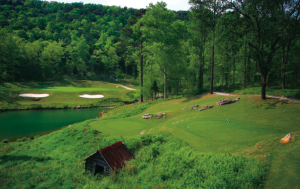Gomer Pyle, one of television’s most beloved characters of the 1960s, often said this about life in general: “Well, surprise, surprise, surprise.” On a recent visit to northern Alabama, I found myself thinking the same thing. I had been to the lower part of the state a few times — Gulf Shores and Mobile — and had been impressed but not surprised by the scenery, southern hospitality, great food, and wide variety of fine golf courses. I figured northern Alabama would have to go hard to beat that.
At least, that’s what I thought.

The stunning, 393-yard, par-4 finisher at The Shoals’ Schoolmaster course forces you to flirt with Wilson Lake.
Northeast of the state’s largest city, Birmingham, in Glencoe, I had my first eye opener — in more ways than one. Silver Lakes Golf Club is a member of Alabama’s well known and wildly successful Robert Trent Jones Golf Trail, a string of 11 facilities that runs from the top of the state to the bottom. This 36-hole facility (including a nine hole par-3 course) opened in 1993. With extreme clarity the names of the three regulation nines here — Heartbreaker, Backbreaker and Mindbreaker — tell you all you need to know about the type of golf that’s featured and why playing from the tee boxes that match your ability is a must. To say these course combinations are tough is like saying Mt. Everest is tall. From the back tees, each combination measures over 7,400 yards, tipping out with the Heartbreaker/ Backbreaker duo at 7,624 yards. Add in the numerous forced carries, ponds, lakes and bunkers, and finish it all off with some seriously sloped putting surfaces, and it’s fair to say that Silver Lakes just might not be for the faint of heart, back or mind. On the other hand, if long and demanding golf is what you’re looking for, this is a dream come true. I can’t imagine how challenging Silver Lakes was prior to April of 2011, when an EF-4 tornado plowed through the property and took out well over 30,000 trees lining the holes.
Twin Bridges Golf Club in the nearby city of Gadsden is a much less demanding alternative to the Trail but still a fine challenge. Designed by Gene Bates and opened in 2002, Twin Bridges is a pretty and very playable layout set along the Coosa River. Refreshingly, this tree-lined tract only measures 6,734 yards from the back tees (three other markers are available) but that doesn’t mean it’s easy. Water is in play on 11 holes, there are several forced carries and the course is well bunkered. The sand at many southern courses, by the way, is very soft and heavy. Especially for greenside bunkers, a wedge with plenty of bounce is required equipment. To my surprise, Twin Bridges was the first of several courses on my visit to northern Alabama to feature bentgrass greens, arguably a better putting surface than the Bermudagrass greens that are more common in the South and West but rarely able to thrive in the heat and humidity. At Twin Bridges, apparently, TLC goes a long way.

The rocky, rolling terrain provides plenty of drama at the Jerry Pate-designed Limestone Springs, including the 148-yard, par-3 seventh hole. Photo by Nile Young, Jr.
I have a confession to make: I love Jerry Pate. Check that. I’m not in love with the 1976 U.S. Open champion and current member of the Champions Tour, I just love the golf courses he has designed that I’ve had the good fortune to play. The two courses he co-designed at Dancing Rabbit in central Mississippi (Azaleas and Oaks) are sensational. Steelwood Country Club in Loxley, Alabama, east of Mobile, is outstanding. And now, thanks to my visit to northern Alabama, I have another one to rave about: Limestone Springs. Nestled within the foothills of the Appalachian Mountains, in the town of Oneonta (roughly 30 miles west of Gadsden), Limestone Springs is but one on a growing list of fine courses throughout the U.S. that are owned and/or operated by Honours Golf out of Birmingham just 25 miles to the south. One thing Honours Golf guarantees is a high level of conditioning, and you get it here at Limestone Springs. Trust me: country club conditions on a public access course are hard to find — especially at such affordable rates. Surprisingly, one knock I heard about Limestone Springs is that it’s a bit far from the city. Seriously? Where I live, I make a 40-mile round trip just to play my favorite muni … and it doesn’t have anywhere near the towering trees, spectacular scenery, massive rock outcroppings or gorgeous golf holes. This course begins with an opening drive from an elevated tee 80 feet down to the fairway. If I lived near Limestone Springs, I’d play it every week.
North of Limestone Springs, in Union Grove (30 miles south of Huntsville), is another standout Honours Golf facility: Cherokee Ridge. Unlike Limestone Springs, Cherokee Ridge is a semi-private course that’s laid out within a residential community (the handsome homes bordering many of the holes only add to the beauty). Designed by Sammy Dean and opened in 1992, Cherokee Ridge measures just over 6,700 yards from the back tees (multiple tees are available). Like Limestone Springs, Cherokee Ridge features panoramic views of the foothills of the Appalachians, numerous tree-lined fairways, serious elevation changes and impeccable conditions. A 17-acre lake is in play on several holes on the front nine; the back nine meanders through a forest of pines and hardwoods. An additional highlight on the back nine are the views from three holes of an 80-foot waterfall crashing down into Lynn’s Creek. The fairways are narrow, there’s plenty of trouble to avoid, and the good-sized bentgrass greens are speedy and well sloped. For a course that’s considered short by today’s standards, it’s surprising that Cherokee Ridge was the site of a Nike Tour event during the mid 1990s. But then, that should tell you something about the quality of this golf course and how challenging it can be. Surprising as well are the reasonable rates for non- members ($59, with cart). Believe it: if Cherokee Ridge and Limestone Springs were located in the Midwest or northeast, players during peak season would be paying $150 or more for the experience. Lodging is also available at Cherokee Ridge via a fully-furnished, on-site lake house that overlooks the golf course and can accommodate up to 20 guests.
The most northern site on the RTJ Golf Trail is Hampton Cove in Huntsville (known as the “Rocket City” due to its many contributions to space exploration). There are two regulation courses here — Highlands and River — and an 18-hole short course. The two big courses at Hampton Cove are complete opposites. Renovated in 2008, the Highlands features rolling terrain, tall native grasses, and the look and feel of a links course straight out of Scotland or Ireland. Four sets of tees are available, ranging in length between 4,951 yards and 7,428 yards. In case you haven’t noticed, challenge and length are hallmarks on the Trail. From the back tees, all four of the par-3s at the Highlands measure over 200 yards and the par-5 17th tips out at 621 yards. Right across the street, built on what was once soybean fields, the River Course is a totally different canvas. Instead of rolling terrain, the topography here can only be called flat. In addition, the River is the only course on the Trail without a single bunker. Before you breathe a sigh of relief, though, be advised that water is in play on 16 of the 18 holes, the greens are well sloped, and the course is wide open to the wind. On top of all that, the River course is even longer than the Highlands. From the tips, the River measures a whopping 7,668 yards (relax, three other tees are available).
And if that’s not big enough … an hour and a half west of Huntsville, in Muscle Shoals, at the RTJGT site known as “The Shoals,” you’ll find the two longest courses on the Trail. “The Schoolmaster” course (named for President Woodrow Wilson, who was known as “The Schoolmaster of Politics” in his day) measures just under 8,000 yards from the back tees. As you may recall, President Wilson was partly responsible for a much-needed dam being built on the Tennessee River in the nearby city of Florence. Here you will also find home to the beautiful, luxurious and highly- rated Marriott Shoals Hotel & Spa. But wait. “Fighting Joe” — The Shoals’ course named for Confederate General Joe Wheeler — tips out at nearly 8,100 yards. Yes, I know: that sounds crazy.
But is it? Because as we all know, there are lots of golfers — particularly younger, male golfers — who feel they’ve got the game and the long ball to handle every course they play from the back tees. Whether they can or not doesn’t matter. What matters to them is the opportunity — actually the requirement — to grip it and rip it from every tee.
Thankfully (and wisely), both The Schoolmaster and Fighting Joe offer multiple tees to choose from, and each turned out to be extremely playable and a ton of fun. For a short hitter like me, that may have been the biggest surprise of all.
When it comes to a trip to northern Alabama, you, too, will be surprised, surprised, surprised.
Please visit www.tourism.alabama.gov, www.rtjgolf.com or www.honoursgolf.com for more information.

 ';
';
 ';
';
 ';
';
 ';
';